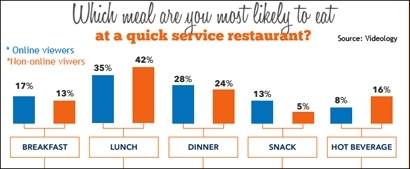
Everyone gets hungry, but new
research suggests online video viewers are more likely to visit a quick service restaurant (QSR) than non-online video viewers as a direct result advertisements.
Programmatic video ad
platform Videology has released an infographic comparing the QSR eating habits of online video viewers to non-online video viewers.
Videology says online video viewers are 60% more likely
to visit a QSR after hearing about a promotion or seeing an advertisement. Nearly half (48%) of online video viewers say an ad or promotion has influenced their decision to visit or buy certain items
at a QSR, while 30% of non-online video viewers say they have been swayed by an ad.
Online video viewers are more likely to go to a QSR for breakfast, dinner or a snack. They are 17% more
likely to purchase dinner at a QSR than their non-online counterparts.
However, non-online video viewers are 20% more likely to go to a QSR for lunch and 100% more likely to visit a QSR for
a hot beverage.
When it comes to spending, Videology says online video viewers are 70% more likely to spend $10 or more at a QSR, while the non-online viewers dominate the $5-$10 category.
Over half (56%) of non-online viewer respondents said they would spend $5-$10 at a QSR.
The spending figures correlate to the “which meal” question the respondents were
presented with. As video viewers are more likely to go for breakfast and dinner, while non-video viewers are more likely to go for lunch or a simple beverage, it makes sense the online crowd would
expect to spend more.
It’s a self-serving report, but a Videology representative asserts the company did not survey any of its own user base. While the company did provide the survey
questions, the rep said the survey was done anonymously, meaning the participants did not know it was conducted by Videology. The rep said Videology used a third-party survey company to carry out the
questionnaire, though the name of the third-party company was not given.
The company surveyed 211 U.S. respondents in March 2014 for the report.